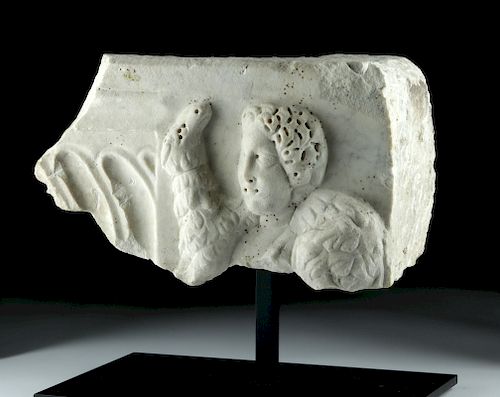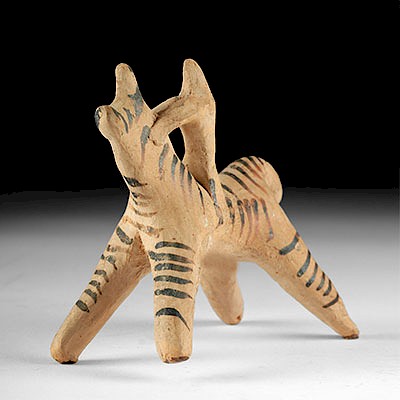Roman Marble Sarcophagus Section - Winged Erote
Lot 81
About Seller
Artemis Fine Arts
686 S Taylor Ave, Ste 106
Louisville, CO 80027
United States
Selling antiquities, ancient and ethnographic art online since 1993, Artemis Gallery specializes in Classical Antiquities (Egyptian, Greek, Roman, Near Eastern), Asian, Pre-Columbian, African / Tribal / Oceanographic art. Our extensive inventory includes pottery, stone, metal, wood, glass and textil...Read more
Estimate:
$5,000 - $7,500
Absentee vs Live bid
Two ways to bid:
- Leave a max absentee bid and the platform will bid on your behalf up to your maximum bid during the live auction.
- Bid live during the auction and your bids will be submitted real-time to the auctioneer.
Bid Increments
| Price | Bid Increment |
|---|---|
| $0 | $25 |
| $300 | $50 |
| $1,000 | $100 |
| $2,000 | $250 |
| $5,000 | $500 |
| $10,000 | $1,000 |
| $20,000 | $2,500 |
| $50,000 | $5,000 |
| $100,000 | $10,000 |
| $200,000 | $20,000 |
About Auction
By Artemis Fine Arts
Oct 25, 2018
Set Reminder
2018-10-25 11:00:00
2018-10-25 11:00:00
America/New_York
Bidsquare
Bidsquare : Antiquities from Egypt, Greece, Italy, Asia
https://www.bidsquare.com/auctions/artemis-gallery/antiquities-from-egypt-greece-italy-asia-3538
Featuring Egyptian, Greek, Roman, Etruscan, Near Eastern, plus Asian art from Central and Far East. If you love the classics, this is the sale for you. Artemis Fine Arts info@artemisfinearts.com
Featuring Egyptian, Greek, Roman, Etruscan, Near Eastern, plus Asian art from Central and Far East. If you love the classics, this is the sale for you. Artemis Fine Arts info@artemisfinearts.com
- Lot Description
Roman, Imperial Period, ca. 1st to 3rd century CE. Finely carved in low to high relief - a large section of a marble sarcophagus - the curved interior edge suggesting it was located at the corner of a sarcophagus - depicting a winged cherub, perhaps Cupid (Eros), with finely delineated feathery wings, facing the flaming torch to his right. In addition to possessing an impressive ability to render flesh from stone, the sculptor of this piece was skilled in communicating naturalism in Cupid's facial features - those generously lidded, almond-shaped eyes, apple cheeks, full lips, and that fleshy nose - framed by a wavy coiffure with curly locks. To the left is an elegantly detailed entablature with repeated curvilinear motifs below demarcated concave and convex bands. Size: 14.875" W x 8.375" H (37.8 cm x 21.3 cm); 13.75" H (34.9 cm) on included custom stand.
Cupid or Eros was the mischievous yet endearing god of love, a minion, constant companion, and according to some classical writers, a son of the goddess Venus/Aphrodite. In the Roman period, Cupid had become a child, whereas to the earlier Greeks, Eros was a muscular youth. In time, ancient poets and artists multiplied Eros into a group of Erotes - winged gods of love or Roman Cupides. Hesiod describes a pair - Eros (Love) and Himeros (Desire) - both present at the birth of Aphrodite. However, later writers added a third Erote named Pothos (Passion). Some depicted twin Erotes - Eros (Love) and Anteros (Love Reciprocated) - who were usually shown gracing the scales of love. Eventually, poets multiplied them to envision an even greater number of winged putti. Indeed, the Erotes were the creations of poetic invention without any distinct mythology of their own - as opposed to Cupid/Eros, the God of Love.
Sarcophagi became more popular at the beginning of the 2nd century CE when burial grew more favorable than cremation. Carved from stone, in this case marble, the panels were adorned with high and low relief mythological scenes, and by the 2nd century, it was also common to include a portrait of the deceased in a heroic guise. A rare and beauteous piece from ancient Rome!
Provenance: private East Coast, USA collection
All items legal to buy/sell under U.S. Statute covering cultural patrimony Code 2600, CHAPTER 14, and are guaranteed to be as described or your money back.
A Certificate of Authenticity will accompany all winning bids.
We ship worldwide and handle all shipping in-house for your convenience.
#136983A section from a larger sarcophagus. Losses/abrasions/nicks to edges and high pointed areas as shown. There is a trace of pale green pigment at the upper left of the entablature.Condition
- Shipping Info
-
All shipping is handled in-house for your convenience. Your invoice from Artemis Gallery will include shipping calculation instructions. If in doubt, please inquire BEFORE bidding for estimated shipping costs for individual items.
-
- Buyer's Premium



 EUR
EUR CAD
CAD AUD
AUD GBP
GBP MXN
MXN HKD
HKD CNY
CNY MYR
MYR SEK
SEK SGD
SGD CHF
CHF THB
THB














